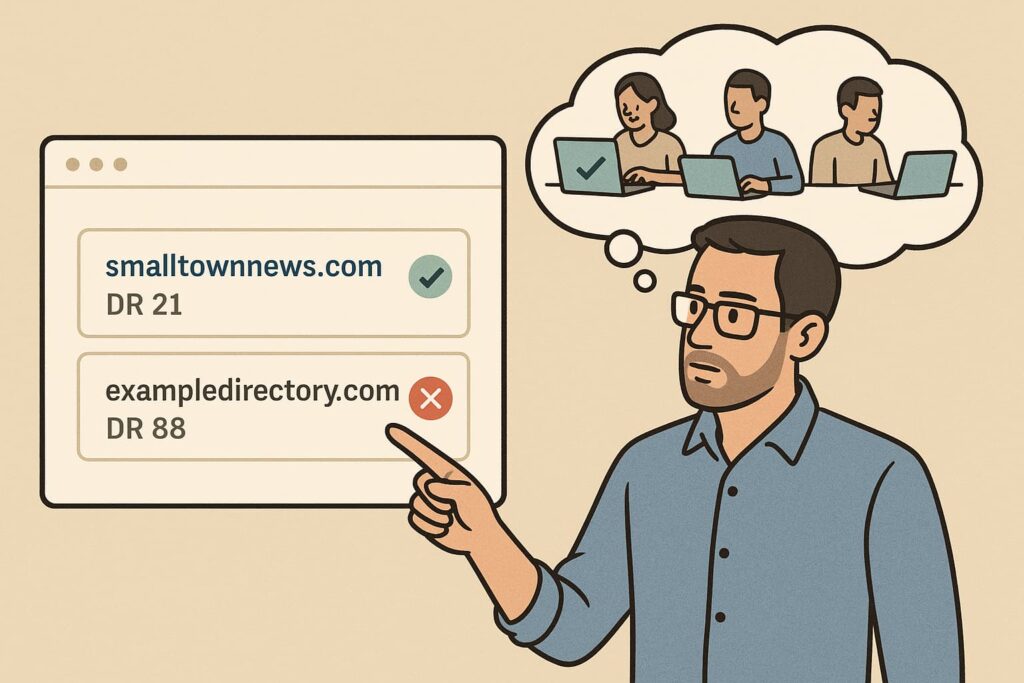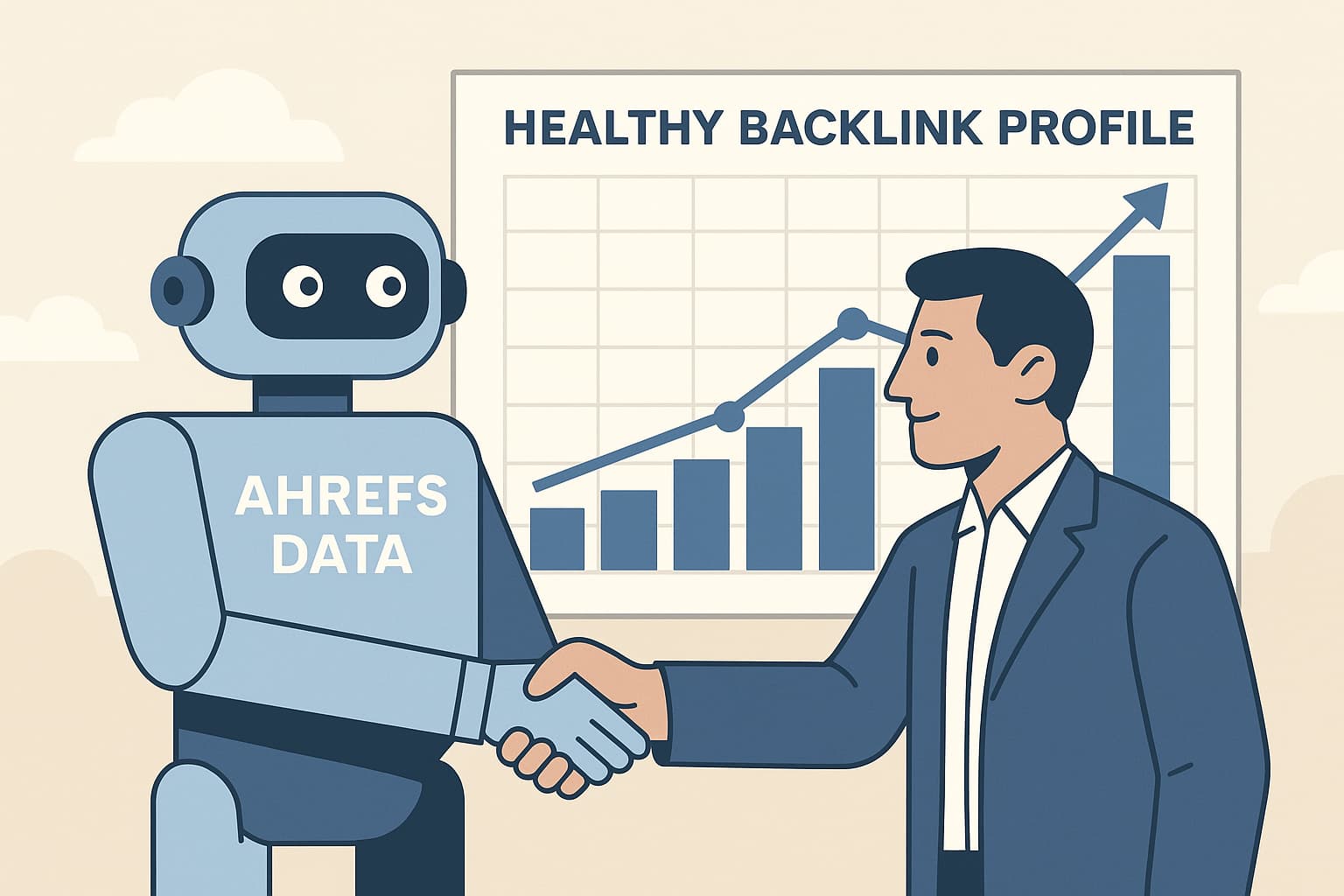A strong backlink profile is critical for SEO success, but not all links are beneficial. Some can harm your rankings if they come from spammy or irrelevant sources. To ensure your link profile is clean and effective, combining Ahrefs with human auditors is the best approach. Automated tools like Ahrefs provide data, but human expertise interprets it accurately, removing risks that AI alone might miss.
Why Ahrefs Alone Isn’t Enough
Ahrefs is one of the most effective SEO tools for backlink analysis. It crawls the web, identifies links pointing to your site, and provides metrics like Domain Rating (DR), URL Rating (UR), and anchor text distribution. However, it has limitations:
- False flags: May mislabel good or bad links.
- No context: Can’t judge if a link is editorial or manipulative.
- Outdated signals: Doesn’t always align with Google’s latest updates.
This is where human auditors add value.
How Human Auditors Improve Link Audits
Experienced SEOs manually review links to determine their real impact. Here’s what they do differently:
1. Evaluating Link Intent
Links can’t be judged by numbers alone. A skilled auditor looks beyond domain ratings to assess a link’s true value. That small-town newspaper link might send targeted local traffic despite its low authority score, while that “high-DR” directory could be pure spam. They examine how naturally the link appears in content, whether the referring site has a real audience, and if the connection makes logical sense for both websites.
2. Spotting Manipulative Patterns
Today’s black hat SEO tactics are more sophisticated than ever. Human reviewers spot what algorithms miss—like when multiple “different” websites actually share the same registration details, content patterns, or suspicious backlink profiles. They’ll notice if your anchor text distribution looks unnaturally perfect, or if those “organic” links suddenly appeared from unrelated industries. These subtle signs often reveal private blog networks and other manipulative setups that tools can’t reliably identify.
The human element in link auditing provides the contextual understanding that no algorithm currently possesses. Where tools see numbers and patterns, experienced auditors understand intent, quality, and the ever-changing standards of search engines. This combination of technical analysis and human judgment creates the most accurate picture of your backlink profile’s health.
3. Bringing Valuable Links Back to Life
Even the best backlinks can vanish when websites get redesigned, content gets updated, or pages accidentally get deleted. While tools only show your current links, human auditors dig into your historical backlink data like digital archaeologists.
They track down those lost connections from authoritative sites and personally reach out to webmasters — sometimes just asking nicely is all it takes to get that valuable link restored. Often, reclaiming these established links gives you a bigger SEO boost than chasing new ones.
4. Smart Competitive Research
Sure, Ahrefs can spit out a giant list of your competitors’ backlinks. But which ones should you actually go after? That’s where human expertise comes in. Seasoned auditors look at competitor links through a strategic lens, asking: Is this site actually relevant to our business? Does it drive real traffic? How hard would it be to get a similar link?
They’ll even investigate things like a site’s guest post policies before recommending any outreach. This saves you from wasting time chasing links that look good on paper but won’t move the needle.
5. Disavow Decisions Done Right
The disavow tool should be used with caution. Human reviewers assess each questionable link individually before making a decision. They can distinguish between truly harmful links and those that are low-quality but not dangerous. They also consider the link’s background—such as whether it came from an old SEO campaign. This helps avoid mistakenly removing links that aren’t actually a problem.
The Step-by-Step Link Audit Process (Ahrefs + Humans)

A proper link audit needs both Ahrefs’ data-crunching power and human expertise. While Ahrefs gathers all the link information, SEO pros analyze it using their experience and knowledge of search engine rules. Together, they catch what tools might miss and find the best linking opportunities. Here’s how it works step by step:
Step 1: Backlink Data Extraction
Ahrefs extracts all current and historical backlinks associated with the site. This historical perspective proves particularly valuable—a significant drop in links following a Google update may indicate previously used risky link-building tactics.
Key indicators examined during this stage include:
- Sudden influxes of links from irrelevant industries;
- Patterns suggesting potential negative SEO activity;
- Suspicious timing of link acquisitions that could signal artificial link-building.
The collected data forms the foundation for identifying both risks and opportunities within the link profile.
Step 2: Initial Filtering
Ahrefs flags links with low DR, high spam scores, or toxic indicators. The auditor reviews these manually to confirm legitimacy. Not all low-DR links are harmful—some could be from niche-relevant blogs with engaged audiences. Conversely, some high-DR links might come from link farms disguised as legitimate sites. Human judgment is necessary to separate truly toxic links from those that are simply low-authority but harmless.
Step 3: Anchor Text Analysis
A healthy backlink profile should have a natural mix of anchor texts. If you see too many exact-match keyword links, that’s a red flag that could get you penalized. Experienced SEOs manually review anchor text distribution, looking for the right balance of branded links (like your company name), generic phrases (‘click here’), and relevant keywords.
They also watch for telltale signs of manipulation—like seeing the same overly optimized anchor text popping up across multiple unrelated sites, which often means someone’s buying links or using a private blog network.
Step 4: Link Quality Check
Auditors visit linking pages to verify:
- Is the link editorial (naturally placed)? Or is it stuffed in footers, sidebars, or auto-generated content?
- Does the site have real traffic, or is it a PBN? They look for signs of artificial engagement, such as fake comments or templated designs.
- Is the content relevant to your niche? A link from a completely unrelated site (e.g., a poker blog linking to a dentist’s website) is a red flag.
Step 5: Competitor Comparison
Ahrefs identifies links competitors have that you don’t. Humans prioritize which ones are worth acquiring based on relevance and authority. They also assess the feasibility of obtaining similar links—for example, if a competitor earned a link through high-quality guest content, replicating that strategy might be worthwhile.
Step 6: Toxic Link Removal
If harmful links are found, auditors contact webmasters for removal. If unsuccessful, they prepare a disavow file—but only after careful review. They avoid mass-disavowing links, as overuse can accidentally remove neutral or even beneficial links. Each disavow decision is documented to ensure transparency.
Step 7: Actionable Recommendations
The final report includes:
- Link recommendations: What to keep, remove, or disavow—with clear reasons.
- Link-building targets: High-value opportunities ranked by impact and effort.
- Content tactics: Proven ideas like expert roundups or data studies to attract links.
This structured yet flexible process ensures that every link audit is thorough, accurate, and tailored to a site’s unique SEO needs.
When to Consider a Professional Link Audit

You don’t always need link audits, but there are some cases where expert assistance is required. If your rankings fall or you suspect bad backlinks, skilled analysis may help you uncover the issue and avoid additional damage.
1. When Your Rankings Suddenly Tank
If your search traffic takes an unexpected nosedive and you can’t point to obvious causes like algorithm updates or site errors, your backlinks might be to blame. Maybe Google decided some of your links look fishy, or worse—a competitor might be sabotaging you with spammy links. A pro audit will uncover exactly which links are dragging you down so you can fix the problem fast.
2. When Google Slaps You With a Manual Penalty
If you see a “Manual Action” alert in Google Search Console, it means real people at Google have reviewed your backlinks and found them suspicious. Unlike algorithmic penalties, these warnings won’t go away on their own—you’ll need to clean up your link profile and prove you’ve fixed the issue.
This is where professional auditors help. They know exactly what Google wants to see and can guide you in removing harmful links, submitting a reconsideration request, and getting your site back in good standing.
3. History of Shady Link-Building
If your site previously used risky tactics like PBNs, link exchanges, or purchased links (common in older SEO strategies), these could still be harming you even years later. Professionals can identify which legacy links need removal versus which might be grandfathered in as acceptable.
4. No Recent Backlink Audits
If it’s been over 6-12 months since your last comprehensive link analysis, you’re flying blind. New toxic links may have appeared naturally, or your competitors may have built links you’re missing out on. Regular audits (at least annually) are crucial for maintenance.
5. Preparing for Major SEO Campaigns
Before launching aggressive link-building efforts or site migrations, an audit ensures you’re building on a clean foundation. The last thing you want is to attract Google scrutiny right as you’re trying to grow.
6. Competitor Outperformance
When competitors rank higher despite having similar content, their backlink profile often reveals why. A professional audit uncovers these strategic advantages, pinpointing exactly where your own link profile falls short.
But here’s the real value: a quality audit doesn’t just point out problems—it gives you a playbook for long-term success. Take 3XE Digital‘s approach: they don’t just run automated scans. Real experts dig through your backlinks to find toxic ones, flag suspicious anchor text patterns, and spot golden opportunities you’re missing. They’ll even stack your link profile against your top competitors’, then give you customized strategies to not just catch up, but pull ahead. The result? A backlink profile that grows your rankings without risking penalties.
Conclusion
Ahrefs is an effective tool, but human judgment is irreplaceable in link audits. Combining both eliminates guesswork, prevents unnecessary disavows, and ensures only high-quality links contribute to your rankings. Whether you audit links yourself or hire professionals, this hybrid approach is the most reliable way to protect and improve your SEO performance.
